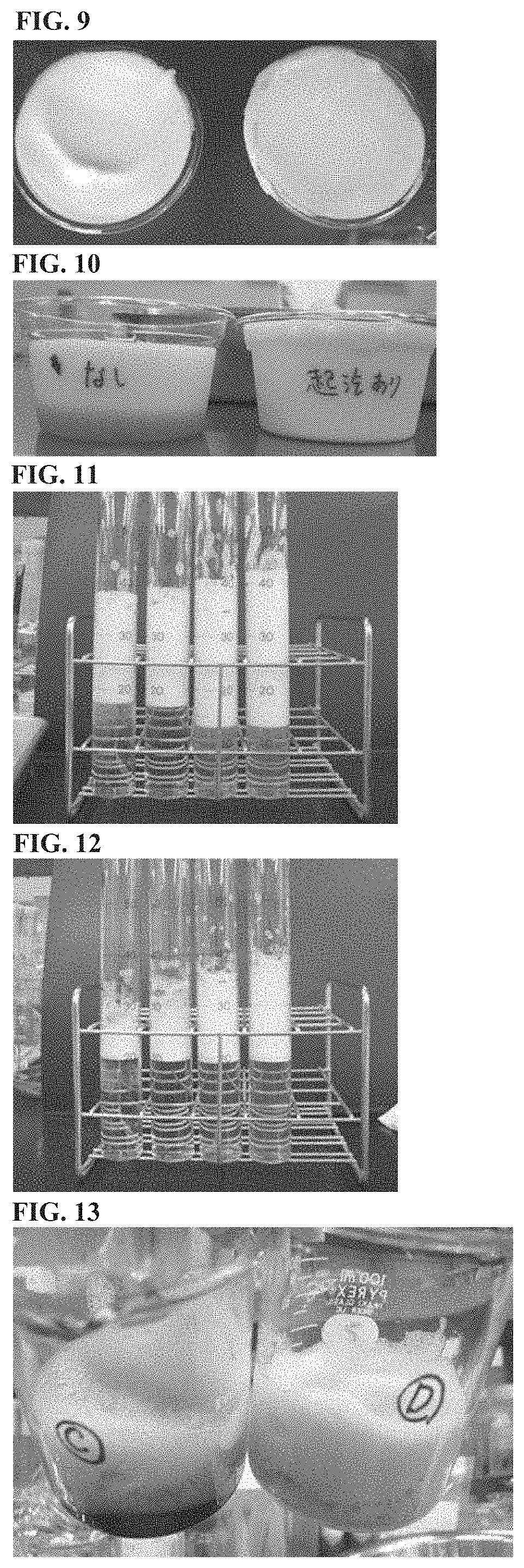Foaming material
a foaming material and foaming technology, applied in the field of foaming materials, can solve the problems of insufficient foaming properties, insufficient stability of generated bubbles, and deterioration of product quality, so as to improve the quality of a bubble-containing product, improve the foaming property, and improve the stability of bubbles.
- Summary
- Abstract
- Description
- Claims
- Application Information
AI Technical Summary
Benefits of technology
Problems solved by technology
Method used
Image
Examples
production example 1
[0054]The pH of 1000 ml of a cell suspension of Candida utilis CBS 6316 strain (FERM BP-1657 strain) at 10% by weight (dry cell weight) was adjusted to 3.5 with 10 N sulfuric acid and treated at 70° C. for 30 minutes, and the cells were recovered by centrifugation and washed with water to remove sulfuric acid and excess extracts. The present cells were adjusted with water to have a cell concentration (dry cell weight) of 10% by weight, suspended, then adjusted to a pH of 9 by adding a solution of caustic soda thereto, and treated at 65° C. for 60 minutes to extract the extract therefrom. The yeast cell residue after the extraction of extract was used as a raw material for the foaming material.
[0055]Water was added to the above yeast cell residue to prepare a cell suspension having a concentration of about 10% by weight, and the pH of the cell suspension was adjusted to 2.0 with hydrochloric acid. This yeast cell suspension was subjected to a heat treatment at 110° C. for 90 minutes ...
production example 2
[0057]A yeast extract was obtained in the same manner as in Production Example 1 except that the cell suspension having a concentration of about 10% by weight was adjusted to a pH of 8.0 with a solution of caustic soda instead of being adjusted to a pH of 2.0 with hydrochloric acid in Production Example 1, and it was used as the yeast extract of Production Example 2.
production example 3
, Production Example 4, and Production Example 5
[0058]The yeast extracts of Production Example 3, Production Example 4, and Production Example 5, were respectively obtained in the same manner as in Production Example 1 except that the cell suspension having a concentration of about 10% by weight was adjusted to a pH of 9.0, 10.0, or 11.0 with a solution of caustic soda instead of being adjusted to a pH of 2.0 with hydrochloric acid in Production Example 1.
[0059](Foaming Activity Test 1)
PUM
| Property | Measurement | Unit |
|---|---|---|
| pH | aaaaa | aaaaa |
| pH | aaaaa | aaaaa |
| volume | aaaaa | aaaaa |
Abstract
Description
Claims
Application Information
 Login to View More
Login to View More - R&D
- Intellectual Property
- Life Sciences
- Materials
- Tech Scout
- Unparalleled Data Quality
- Higher Quality Content
- 60% Fewer Hallucinations
Browse by: Latest US Patents, China's latest patents, Technical Efficacy Thesaurus, Application Domain, Technology Topic, Popular Technical Reports.
© 2025 PatSnap. All rights reserved.Legal|Privacy policy|Modern Slavery Act Transparency Statement|Sitemap|About US| Contact US: help@patsnap.com



